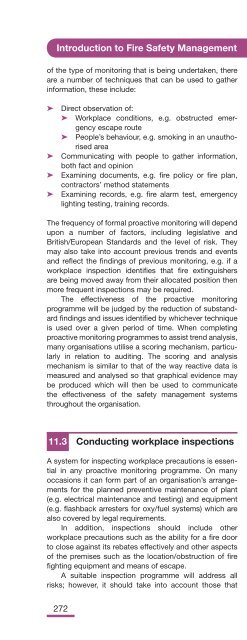Introduction to Fire Safety Management
Introduction to Fire Safety Management
Introduction to Fire Safety Management
You also want an ePaper? Increase the reach of your titles
YUMPU automatically turns print PDFs into web optimized ePapers that Google loves.
<strong>Introduction</strong> <strong>to</strong> <strong>Fire</strong> <strong>Safety</strong> <strong>Management</strong><br />
of the type of moni<strong>to</strong>ring that is being undertaken, there<br />
are a number of techniques that can be used <strong>to</strong> gather<br />
information, these include:<br />
➤ Direct observation of:<br />
➤ Workplace conditions, e.g. obstructed emergency<br />
escape route<br />
➤ People’s behaviour, e.g. smoking in an unauthorised<br />
area<br />
➤ Communicating with people <strong>to</strong> gather information,<br />
both fact and opinion<br />
➤ Examining documents, e.g. fi re policy or fi re plan,<br />
contrac<strong>to</strong>rs’ method statements<br />
➤ Examining records, e.g. fi re alarm test, emergency<br />
lighting testing, training records.<br />
The frequency of formal proactive moni<strong>to</strong>ring will depend<br />
upon a number of fac<strong>to</strong>rs, including legislative and<br />
British/European Standards and the level of risk. They<br />
may also take in<strong>to</strong> account previous trends and events<br />
and refl ect the fi ndings of previous moni<strong>to</strong>ring, e.g. if a<br />
workplace inspection identifi es that fi re extinguishers<br />
are being moved away from their allocated position then<br />
more frequent inspections may be required.<br />
The effectiveness of the proactive moni<strong>to</strong>ring<br />
programme will be judged by the reduction of substandard<br />
fi ndings and issues identifi ed by whichever technique<br />
is used over a given period of time. When completing<br />
proactive moni<strong>to</strong>ring programmes <strong>to</strong> assist trend analysis,<br />
many organisations utilise a scoring mechanism, particularly<br />
in relation <strong>to</strong> auditing. The scoring and analysis<br />
mechanism is similar <strong>to</strong> that of the way reactive data is<br />
measured and analysed so that graphical evidence may<br />
be produced which will then be used <strong>to</strong> communicate<br />
the effectiveness of the safety management systems<br />
throughout the organisation.<br />
11.3 Conducting workplace inspections<br />
A system for inspecting workplace precautions is essential<br />
in any proactive moni<strong>to</strong>ring programme. On many<br />
occasions it can form part of an organisation’s arrangements<br />
for the planned preventive maintenance of plant<br />
(e.g. electrical maintenance and testing) and equipment<br />
(e.g. fl ashback arresters for oxy/fuel systems) which are<br />
also covered by legal requirements.<br />
In addition, inspections should include other<br />
workplace precautions such as the ability for a fi re door<br />
<strong>to</strong> close against its rebates effectively and other aspects<br />
of the premises such as the location/obstruction of fi re<br />
fi ghting equipment and means of escape.<br />
A suitable inspection programme will address all<br />
risks; however, it should take in<strong>to</strong> account those that<br />
272<br />
present a low risk (inspections may be undertaken every<br />
month <strong>to</strong> two months) covering a wide range of precautions,<br />
or higher risks that may need more frequent and<br />
detailed inspections such as the s<strong>to</strong>rage and use of<br />
fl ammable materials (inspections may be undertaken<br />
each day or twice daily).<br />
The inspection programme must refl ect any specifi c<br />
legal requirements and the risk priorities which are<br />
usually identifi ed as part of the risk assessment process.<br />
Particularly, in relation <strong>to</strong> fi re, a fi re log book’s<br />
contents and records will refl ect the schedules and<br />
performance standards required by not only the law<br />
but a variety of British and European Standards. These<br />
schedules are likely <strong>to</strong> be supplemented with inspection<br />
forms, checklists or aides-memoires, which will enable<br />
a consistency of approach and assist the individuals<br />
conducting the inspection <strong>to</strong> cover all key requirements<br />
without the need <strong>to</strong> remember each element.<br />
Inspections should be undertaken by competent<br />
persons who are able <strong>to</strong> identify relevant hazards,<br />
workplace precautions and risk control systems, the<br />
standards that need <strong>to</strong> be met and any shortcomings in<br />
the preventive and protective measures. This area will be<br />
discussed later within this section.<br />
11.3.1 Recording an inspection<br />
It may well be that fi re safety inspections are included as<br />
part of a general health and safety workplace inspection<br />
programme. It is likely that a safety inspection form will<br />
be produced <strong>to</strong> ensure that key elements are covered by<br />
the inspection and <strong>to</strong> ensure consistency of approach.<br />
There are a number of key headings which are likely <strong>to</strong><br />
be found on a fi re safety inspection record, whichever<br />
recording mechanism is used. These following items are<br />
should be included as a minimum:<br />
➤ Ignition sources<br />
➤ Fuel and oxygen sources<br />
➤ Specifi c high fi re risk activities<br />
➤ General housekeeping<br />
➤ Means of escape<br />
➤ Warning and detection systems<br />
➤ Emergency lighting<br />
➤ <strong>Fire</strong> fi ghting equipment<br />
➤ Procedures and notices.<br />
Under each of the headings there will be a number of<br />
subquestions <strong>to</strong> confi rm the adequacy of workplace<br />
precautions and management controls which can be<br />
either answered in a closed question technique (yes or<br />
no), or be provided with a score in relation <strong>to</strong> the level of<br />
compliance/non-compliance.<br />
In either of the above cases, where non-compliance<br />
is identifi ed, there should be a mechanism for recording

















